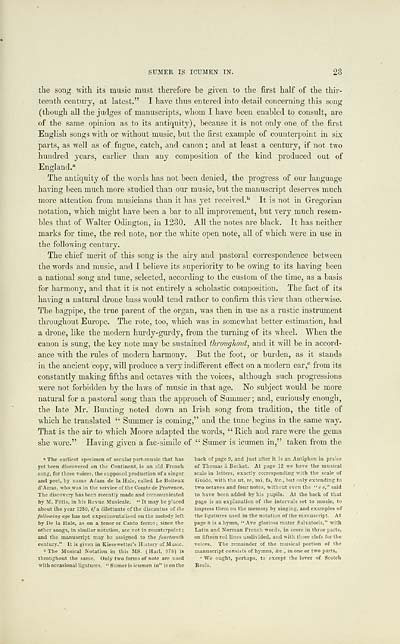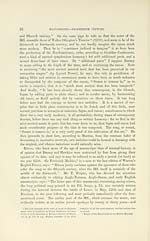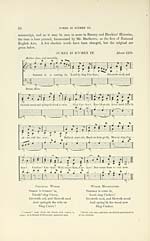Glen Collection of printed music > Printed text > Popular music of the olden time > Volume 1
(57) Page 23
Download files
Complete book:
Individual page:
Thumbnail gallery: Grid view | List view

SUMER IS ICUMEN IN. 23
the song with its music must therefore be given to the first half of the thir-
teenth century, at latest." I have thus entered into detail concerning this song
(though all the judges of manuscripts, whom I have been enabled to consult, are
of the same opmion as to its antiquity), because it is not only one of the first
English songs with or without music, but the first example of counterpoint in six
parts, as well as of fugue, catch, and canon ; and at least a centui-y, if not two
hundi'ed years, eai-lier than any composition of the kind produced out of
England."
The antiquity of the words has not been denied, the progress of our language
having been much more studied than our music, but the manuscript deserves much
more attention from musicians than it has yet received.'' It is not in Gregorian
notation, which might have been a bar to all improvement, but very much resem-
bles that of Walter Odington, in 1230. All the notes are black. It has neither
marks for time, the red note, nor the white open note, all of which were in use in
the following century.
The chief merit of this song is the airy and pastoi'al correspondence between
the words and music, and I believe its superiority to be owing to its having been
a national song and tune, selected, according to the custom of the time, as a basis
for harmony, and that it is not entu'ely a scholastic composition. The fact of its
having a natural di'one bass would tend rather to confirm this view than otherwise.
The bagpipe, the true parent of the organ, was then in use as a rustic instrument
throughout Em-ope. The rote, too, which was in somewhat better estimation, had
a di'one, like the modern hurdy-gm-dy, from the tuniing of its wheel. When the
canon is sung, the key note may be sustained througJwitt, and it will be in accord-
ance with the rules of modern harmony. But the foot, or bm'den, as it stands
in the ancient copy, will produce a very indifierent efiect on a modern ear,'' from its
constantly making fifths and octaves with the voices, although such progressions
were not forbidden by the laws of music in that age. No subject would be more
natural for a pastoral song than the approach of Summer ; and, curiously enough,
the late Mr. Bunting noted down an Irish song from tradition, the title of
which he translated " Summer is coming," and the tune begins in the same way.
That is the air to which Moore adapted the words, " Rich and rare were the gems
she wore." Havmg given a fac-simile of " Sumer is icumen in," taken from the
" The earliest specimen of secular part-music that has back of page B, and just after it is an Antiphon in praise
yet been discovered on the Continent, is an old French of Thomas a Becket. At page 12 we have the musical
song, for three voices, the supposed production of a singer scale in letters, exactly corresponding with the scale of
and poet, by name Adam de la Hale, called Le Boiteux Guido, with the ut, re, mi, fa, &c., but only extending to
d' Arras, who was in the service of the Comte de Provence. two octaves and four notes, without even the "e e," said
The discovery has been recently made and communicated to have been added by his pupils. At the back of that
by M. FHis, in his Revue Musicale. " It may be placed page is an explanation of the intervals set to music, to
about the year 1280, if a, dilettante of the discantus of t!ie impress them on the memory by singing, and examples of
following age has not experimentalised on the melody left the ligatures used in the notation of the manuscript. At
by De la Hale, as on a tenor or Canto fermo; since the page S is a hymn, "Ave gloriosa mater Salvatoris," with
other songs, in similar notation, are not in counterpoint ; Latin and Norman French words, in score in three parts,
and the manuscript may be assigned to the fourieeiith on fifteen red lines undivided, and with three clefs for the
century." It is given in Kiesewetter's History of Music. voices. The remainder of the musical portion of the
''The Musical Notation in this MS. ( Harl. 978) is manuscript consists of hymns, &c., in one or two parts,
throughout the same. Only two forms of note are used "^ We ought, perhaps, to except the lover of Scotch
with occasional ligatures. " Sumeris icumen in" is on the Reels.
the song with its music must therefore be given to the first half of the thir-
teenth century, at latest." I have thus entered into detail concerning this song
(though all the judges of manuscripts, whom I have been enabled to consult, are
of the same opmion as to its antiquity), because it is not only one of the first
English songs with or without music, but the first example of counterpoint in six
parts, as well as of fugue, catch, and canon ; and at least a centui-y, if not two
hundi'ed years, eai-lier than any composition of the kind produced out of
England."
The antiquity of the words has not been denied, the progress of our language
having been much more studied than our music, but the manuscript deserves much
more attention from musicians than it has yet received.'' It is not in Gregorian
notation, which might have been a bar to all improvement, but very much resem-
bles that of Walter Odington, in 1230. All the notes are black. It has neither
marks for time, the red note, nor the white open note, all of which were in use in
the following century.
The chief merit of this song is the airy and pastoi'al correspondence between
the words and music, and I believe its superiority to be owing to its having been
a national song and tune, selected, according to the custom of the time, as a basis
for harmony, and that it is not entu'ely a scholastic composition. The fact of its
having a natural di'one bass would tend rather to confirm this view than otherwise.
The bagpipe, the true parent of the organ, was then in use as a rustic instrument
throughout Em-ope. The rote, too, which was in somewhat better estimation, had
a di'one, like the modern hurdy-gm-dy, from the tuniing of its wheel. When the
canon is sung, the key note may be sustained througJwitt, and it will be in accord-
ance with the rules of modern harmony. But the foot, or bm'den, as it stands
in the ancient copy, will produce a very indifierent efiect on a modern ear,'' from its
constantly making fifths and octaves with the voices, although such progressions
were not forbidden by the laws of music in that age. No subject would be more
natural for a pastoral song than the approach of Summer ; and, curiously enough,
the late Mr. Bunting noted down an Irish song from tradition, the title of
which he translated " Summer is coming," and the tune begins in the same way.
That is the air to which Moore adapted the words, " Rich and rare were the gems
she wore." Havmg given a fac-simile of " Sumer is icumen in," taken from the
" The earliest specimen of secular part-music that has back of page B, and just after it is an Antiphon in praise
yet been discovered on the Continent, is an old French of Thomas a Becket. At page 12 we have the musical
song, for three voices, the supposed production of a singer scale in letters, exactly corresponding with the scale of
and poet, by name Adam de la Hale, called Le Boiteux Guido, with the ut, re, mi, fa, &c., but only extending to
d' Arras, who was in the service of the Comte de Provence. two octaves and four notes, without even the "e e," said
The discovery has been recently made and communicated to have been added by his pupils. At the back of that
by M. FHis, in his Revue Musicale. " It may be placed page is an explanation of the intervals set to music, to
about the year 1280, if a, dilettante of the discantus of t!ie impress them on the memory by singing, and examples of
following age has not experimentalised on the melody left the ligatures used in the notation of the manuscript. At
by De la Hale, as on a tenor or Canto fermo; since the page S is a hymn, "Ave gloriosa mater Salvatoris," with
other songs, in similar notation, are not in counterpoint ; Latin and Norman French words, in score in three parts,
and the manuscript may be assigned to the fourieeiith on fifteen red lines undivided, and with three clefs for the
century." It is given in Kiesewetter's History of Music. voices. The remainder of the musical portion of the
''The Musical Notation in this MS. ( Harl. 978) is manuscript consists of hymns, &c., in one or two parts,
throughout the same. Only two forms of note are used "^ We ought, perhaps, to except the lover of Scotch
with occasional ligatures. " Sumeris icumen in" is on the Reels.
Set display mode to: Large image | Transcription
Images and transcriptions on this page, including medium image downloads, may be used under the Creative Commons Attribution 4.0 International Licence unless otherwise stated. ![]()
| Special collections of printed music > Glen Collection of printed music > Printed text > Popular music of the olden time > Volume 1 > (57) Page 23 |
|---|
| Permanent URL | https://digital.nls.uk/91368131 |
|---|
| Shelfmark | Glen.254 |
|---|---|
| Additional NLS resources: | |
| Attribution and copyright: |
|
| Description | Scottish songs and music of the 18th and early 19th centuries, including music for the Highland bagpipe. These are selected items from the collection of John Glen (1833 to 1904). Also includes a few manuscripts, some treatises, and other books on the subject. |
|---|
| Description | The Glen Collection and the Inglis Collection represent mainly 18th and 19th century Scottish music, including Scottish songs. The collections of Berlioz and Verdi collected by bibliographer Cecil Hopkinson contain contemporary and later editions of the works of the two composers Berlioz and Verdi. |
|---|

